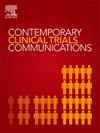羟基脲治疗乌干达儿童镰状细胞性贫血的神经和认知保护(BRAIN SAFE II):单臂开放标签试验方案。
IF 1.4
Q4 MEDICINE, RESEARCH & EXPERIMENTAL
引用次数: 0
摘要
背景:撒哈拉以南非洲患有镰状细胞性贫血(SCA)的儿童是镰状脑血管损伤(SCVI)的高危人群。羟基脲是一种常用的疾病改善疗法,可能会降低SCVI,从而对减少中风和认知功能障碍产生潜在影响。我们的目的是测试每日羟基脲治疗对乌干达SCA患儿这些结果的影响。我们假设羟基脲治疗超过36个月将预防、稳定或改善SCA的这些并发症。方法:BRAIN SAFE II研究是一项开放标签、单臂试验,在乌干达270名年龄3-9岁的SCA (HbSS)儿童中每日使用羟基脲。基线评估后,参与者开始羟基脲治疗,并根据当地指南进行随访。标准羟基脲剂量递增到最大耐受剂量(MTD)。SCVI采用多普勒超声通过脑动脉流速评估,认知功能通过正式的神经认知测试确定(主要结果)。结构性SCVI通过核磁共振成像(MRI)和血管造影(MRA)对90名年龄在50至50岁的参与者进行亚样本评估。在试验中点(18个月)和结束时(36个月),将特定年龄评估的结果与基线以及贫血、炎症和营养不良的生物标志物(次要结果)进行比较,以确定它们与主要结果的关系。结论:本试验将通过降低卒中发生率、卒中风险和神经认知功能障碍来评估羟基脲对预防或改善儿童SCA SCVI的影响。试验结果将为羟基脲治疗在SCA患儿SCVI关键表现中的作用提供重要见解。试验注册:https://clinicaltrials.gov/ct2/show/NCT04750707(注册于2021年2月11日)。协议版本:BRAIN SAFE II协议3.0版,2022年3月2日。本文章由计算机程序翻译,如有差异,请以英文原文为准。
Hydroxyurea therapy for neurological and cognitive protection in pediatric sickle cell anemia in Uganda (BRAIN SAFE II): Protocol for a single-arm open label trial
Background
Children with sickle cell anemia (SCA) in Sub-Saharan Africa are at high risk of sickle cerebrovascular injury (SCVI). Hydroxyurea, a commonly used disease-modifying therapy, may reduce SCVI resulting in potential impact on reducing stroke and cognitive dysfunction. We aim to test the impact of daily hydroxyurea therapy on these outcomes in Ugandan children with SCA. We hypothesized that hydroxyurea therapy over 36 months will prevent, stabilize or improve these complications of SCA.
Methods
The BRAIN SAFE II study is an open label, single arm trial of daily hydroxyurea in 270 children with SCA (HbSS) in Uganda, ages 3–9 years. Following baseline assessments, participants began hydroxyurea therapy and are followed according to local guidelines. Standard hydroxyurea dose is escalated to maximum tolerated dose (MTD). SCVI is assessed by cerebral arterial velocity using Doppler ultrasound, with cognitive function determined by formal neurocognitive testing (primary outcomes). Structural SCVI is assessed by magnetic resonance imaging (MRI) and angiography (MRA) in a sub-sample of 90 participants ages >5 years. At trial midpoint (18 months) and completion (36 months), outcomes of age-specific assessments will be compared to baseline, as well as biomarkers of anemia, inflammation and malnutrition (secondary outcomes) to determine their relationships to primary outcomes.
Conclusion
This trial will examine the impact of hydroxyurea on preventing or ameliorating SCA SCVI in children, assessed by reducing incident stroke, stroke risk and neurocognitive dysfunction. Trial results will provide critical insight into the role of hydroxyurea therapy on critical manifestations of SCVI in children with SCA.
Trial registration
https://clinicaltrials.gov/ct2/show/NCT04750707 (registered 11 February 2021).
Protocol version
BRAIN SAFE II Protocol Version 3.0, Mar 02, 2022.
求助全文
通过发布文献求助,成功后即可免费获取论文全文。
去求助
来源期刊

Contemporary Clinical Trials Communications
Pharmacology, Toxicology and Pharmaceutics-Pharmacology
CiteScore
2.70
自引率
6.70%
发文量
146
审稿时长
20 weeks
期刊介绍:
Contemporary Clinical Trials Communications is an international peer reviewed open access journal that publishes articles pertaining to all aspects of clinical trials, including, but not limited to, design, conduct, analysis, regulation and ethics. Manuscripts submitted should appeal to a readership drawn from a wide range of disciplines including medicine, life science, pharmaceutical science, biostatistics, epidemiology, computer science, management science, behavioral science, and bioethics. Contemporary Clinical Trials Communications is unique in that it is outside the confines of disease specifications, and it strives to increase the transparency of medical research and reduce publication bias by publishing scientifically valid original research findings irrespective of their perceived importance, significance or impact. Both randomized and non-randomized trials are within the scope of the Journal. Some common topics include trial design rationale and methods, operational methodologies and challenges, and positive and negative trial results. In addition to original research, the Journal also welcomes other types of communications including, but are not limited to, methodology reviews, perspectives and discussions. Through timely dissemination of advances in clinical trials, the goal of Contemporary Clinical Trials Communications is to serve as a platform to enhance the communication and collaboration within the global clinical trials community that ultimately advances this field of research for the benefit of patients.
 求助内容:
求助内容: 应助结果提醒方式:
应助结果提醒方式:


